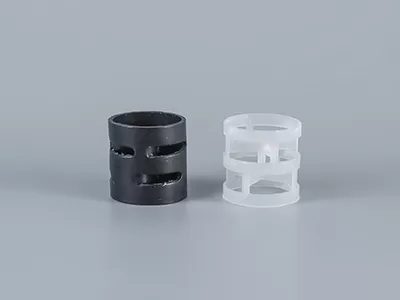The specific gravity of
plastic packing is an important physical property that affects its application and performance. This article will discuss the specific gravity of different plastic packing and the factors influencing it.
The specific gravity of plastic packing varies depending on the type of plastic material used. For example, polypropylene (PP) packing typically has a specific gravity ranging from 0.90 to 0.91 g/cm³. This relatively low specific gravity makes PP packing lightweight, which is beneficial for reducing the load on equipment and simplifying installation processes. It also contributes to lower transportation costs, especially when large quantities of packing are required.

Polyvinyl chloride (PVC) packing has a higher specific gravity compared to PP, usually between 1.35 and 1.45 g/cm³. The higher specific gravity of PVC is due to its molecular structure and the presence of chlorine atoms, which increase the density of the material. This characteristic makes PVC packing more suitable for applications where greater weight or stability is needed, such as in certain industrial settings where the packing must resist movement caused by fluid flow.
Polytetrafluoroethylene (PTFE) packing, known for its excellent chemical resistance, has a specific gravity in the range of 2.1 to 2.3 g/cm³. This relatively high specific gravity is a result of the strong carbon-fluorine bonds in its molecular structure, which give PTFE its unique properties. Despite its higher density, PTFE packing is valued in harsh chemical environments where its resistance to corrosion is crucial, even though it may add more weight to the equipment.

Polyethylene (PE) packing, including low-density polyethylene (LDPE) and high-density polyethylene (HDPE), has a specific gravity that varies based on its density. LDPE packing generally has a specific gravity of 0.91 to 0.92 g/cm³, while HDPE packing has a higher specific gravity, typically between 0.94 and 0.96 g/cm³. The difference in specific gravity between LDPE and HDPE is due to variations in their molecular packing and crystallinity, with HDPE having a more ordered structure that results in higher density.
In addition to the base plastic material, the specific gravity of plastic packing can be influenced by additives and fillers. For instance, some plastic packing may contain inorganic fillers such as calcium carbonate or talc to enhance certain properties like rigidity or heat resistance. These fillers, which often have higher specific gravities than the base plastic, can increase the overall specific gravity of the packing. The amount and type of filler used will determine the extent of this increase.
The structure of the plastic packing can also have a minor impact on its specific gravity. For example,
structured packing with complex geometries or hollow designs may have a slightly lower apparent specific gravity compared to solid packing of the same material, as the presence of voids reduces the overall density. However, this is more related to the bulk density rather than the specific gravity of the material itself, which is an intrinsic property.
Understanding the specific gravity of plastic packing is important for various applications. In industrial processes such as distillation, absorption, and extraction, the specific gravity affects the packing's settling behavior, fluid dynamics, and interaction with other components in the system. It also plays a role in determining the amount of packing that can be loaded into a given volume of equipment, as well as the overall weight that the equipment must support.
In summary, the specific gravity of plastic packing varies by material, with ranges such as 0.90-0.91 g/cm³ for PP, 1.35-1.45 g/cm³ for PVC, 2.1-2.3 g/cm³ for PTFE, and 0.91-0.96 g/cm³ for PE. Additives, fillers, and structural designs can also influence the specific gravity, making it a key consideration in selecting the appropriate plastic packing for specific industrial applications.



